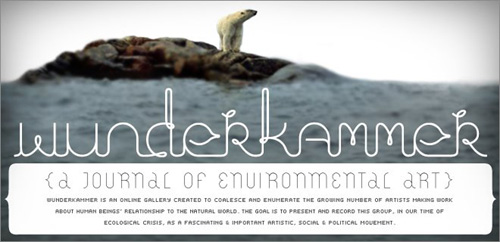
Maslen & Mehra
BY JENNY KENDLER
Wunderkammer: A journal of Environmental Art
http://www.environmentalartblog.com/
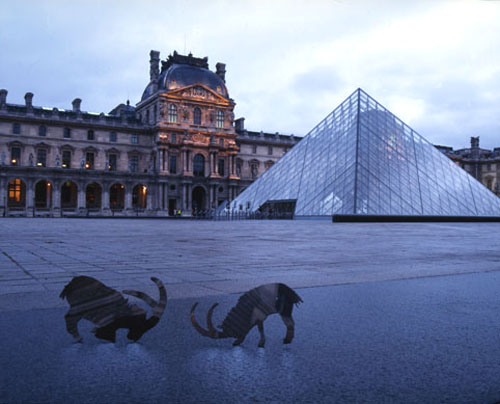
Ibex : Louvre : Paris II -
from the Native Series - non-manipulated photograph of sculpture
-
Maslen & Mehra - 2007
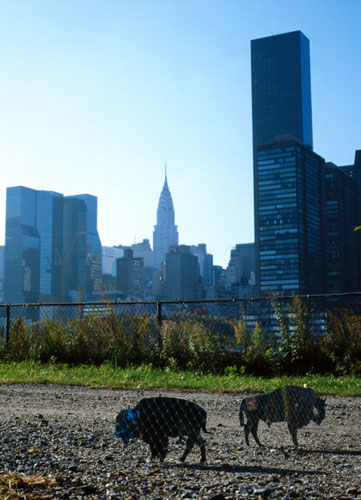
American Buffalo : Roosevelt Island : New York
-
from the Native Series - non-manipulated photograph of sculpture
-
Maslen & Mehra - 2007
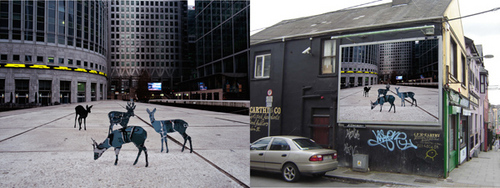
Roe Deer : Docklands : London : I -
from the Native Series - non-manipulated photograph of sculpture/billboard
installation
- Maslen & Mehra - 2007
Tim Maslen
& Jennifer Mehra are a team of artists based in the UK,
who for the last sum of years have been engaging in a powerful
dialog on the natural world's place in today's 'human world.'
In their
Native series (above and throughout), mirrored sculptures
of animals are placed in the urban environment as sculptural
installations which are then documented with large-scale photographs.
The particular species chosen for these temporary interventions
were once were natives of, but are no longer present in, the
areas in which their simulacra are placed. In the gallery,
these works are displayed on reclaimed light boxes, recycled
from their former lives as advertisement frames in London's
subway system. This alone, I love. That this former vehicle
for consumer desire gets re-purposed as an art object designed
to question those very structures is quite clever --- as well
as being a marker of Maslen & Mehra's commitment to an
art practice centered on sustainability.
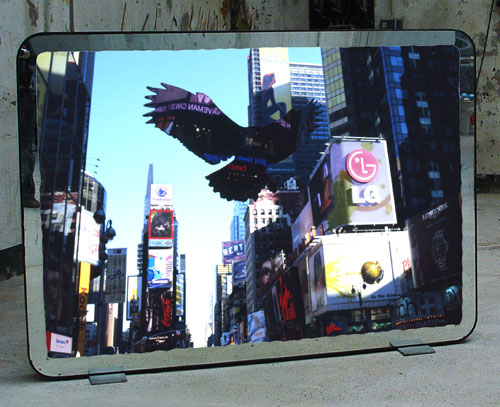
American Eagle : Times Square : New York : VI
from the Native Series - recycled advertising lightbox -
Maslen & Mehra - 2008
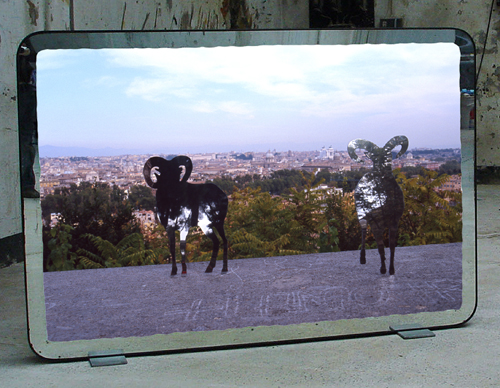
Mouflon : Gianicolo : Rome -
from the Native Series - non-manipulated photograph of sculpture
- Maslen & Mehra - 2007
I see
the photographs as gateways, allowing one to imagine the encounter
with the physical objects, if one is not lucky enough to encounter
them in reality. Their perhaps more potent existence is as
these public sculptures/installations.
Maslen
& Mehra's animal shapes, rather than being 'filled-in'
representations, reflect the urban environment around them
--- displacing their identity outwards. They are creatures
which share our space, but only as cut-outs, windows, absences.
These mirrored forms call out the very thing that has displaced
them --- confronting us with the the phenomenon of habitat
loss, species driven to extinction, and our own alienation
from the animal kingdom and the natural world.
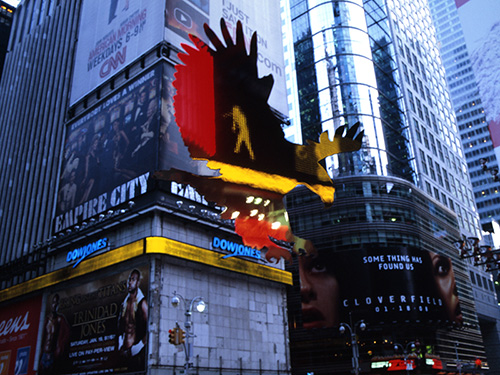
American Eagle : Empire City : New York -
from the Native Series - non-manipulated photograph of sculpture
-
Maslen & Mehra - 2008
When actually
encountering the works in situ, I am compelled to imagine,
what one would also see is oneself --- reflected in the animal
form. A question directed towards our own ersatz dissociation
from the animal clan. We too become the animals on display,
running in the same pack as these silver ghosts. When looking
at these lost creatures, driven from the world we have created,
we look at ourselves, trapped inside the built environment,
faces shining back from inside of haloed animal bodies.
This idea
of the mirror is key to the thorough consideration of these
works. It is what takes the sculptures beyond facsimile. The
mirror interrupts 'the gaze' --- a traditional signifier of
the viewer's ownership over the object/person/animal who is
being viewed, by reflecting that gaze back upon the viewer,
reversing the power dynamic. Acknowledging the act of looking
and being looked at as equally powerful, and giving agency
to both beast and landscape encapsulated in it's form, Maslen
& Mehra's sculptures force us to confront our complicity
in the situation played out by mirror-forms --- the shifting
of the environment to managed and manicured, the dispersal
of species from their traditional habitats, and our own loss
of beauty (in the world and within ourselves) when these creatures
disappear from our collective lives.
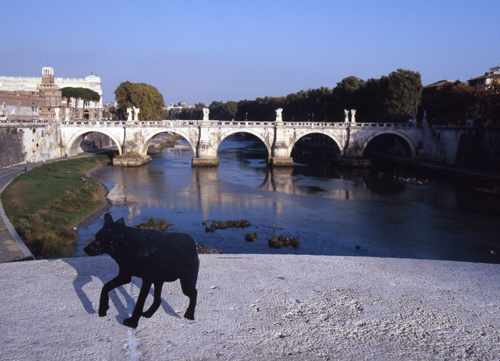
European Wolf : Notre Dame : Paris
Native Series - non-manipulated photograph of sculpture -
Maslen & Mehra - 2007
For the
many human beings on the planet, especially those in cities,
where half of humanity will live by the end of 2008, encounters
with animals are now rarefied events. We generally only encounter
other animals in mediated situations: in zoos, on televisions,
as calendar icons, as feral creatures in our cities, on the
occasional managed safari. Maslen & Mehra's sculptures
set us up to consider just how much we may be missing.
What do
we forfeit if we continue to allow these creatures and environments
to be driven from the Earth? To see a sea eagle dive for a
salmon, drops of water flashing as talons meet river. To walk
the woods in the crisp winter air, and catch a shiver up your
spine upon finding fresh wolf tracks crossing the snowy path
ahead. To see an ibex silhouetted on a far-off rocky crest,
pirouetting, boulder to boulder, so nimbly that it makes you
dizzy. To hear the enormous 'shushing' sound of owl's wings
right above your head on a moonless night. Surely, these are
things worth saving.
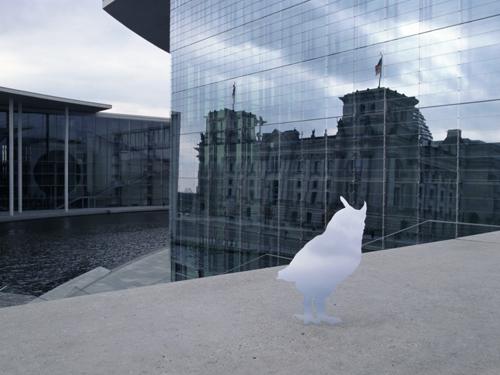
Eagle Owl : Reichstag : Berlin
- from the Native Series - non-manipulated photograph of sculpture
- Maslen & Mehra - 2007
Maslen
& Mehra's mirrored creatures are phantoms, fragile and
impermanent --- spectral reminders of the relationships between
habitats and inhabitants that no longer exist. They are apparitions
from the zoological garden of the distant pre-urban past.
These works, however, are not simply mournful. The mirror
throws things back at us, but it can can also be a doorway
to a new way of thinking. Mirrors show us ourselves, but if
we find that reflected image unsatisfying, they can be a tool
to focus and ignite the desire for change.
These
works, while reminding us of the currently untenable situation
we have created with our environment, are none-the-less hopeful
and generous --- and allow us, the viewers, to see ourselves
through these figures of possibility. They invite us to take
a trip through the looking glass to a past where cities once
were forests, skyscrapers were sequoias, and plazas were open
glades where deer could graze.
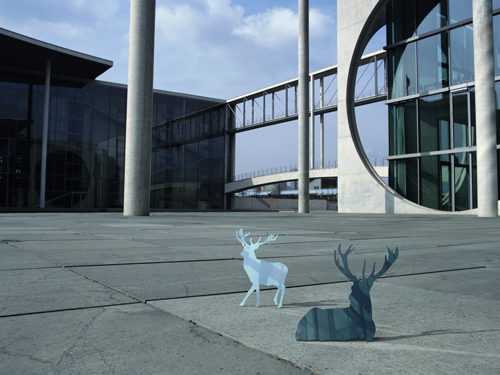
Red Deer : Bibliotheque German Parliament : Berlin -
from the Native Series - non-manipulated photograph of sculpture
-
Maslen & Mehra - 2007
Simultaneously
present and absent, these works help us to recall not only
what no longer is, but to imagine, with a change in vision,
what possibly could still be.